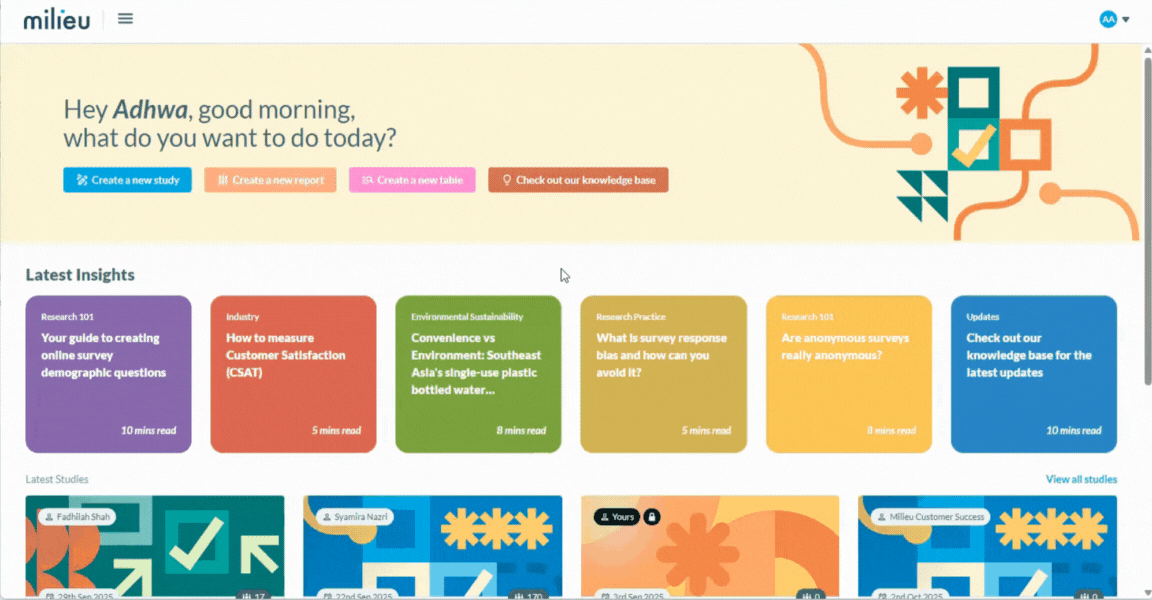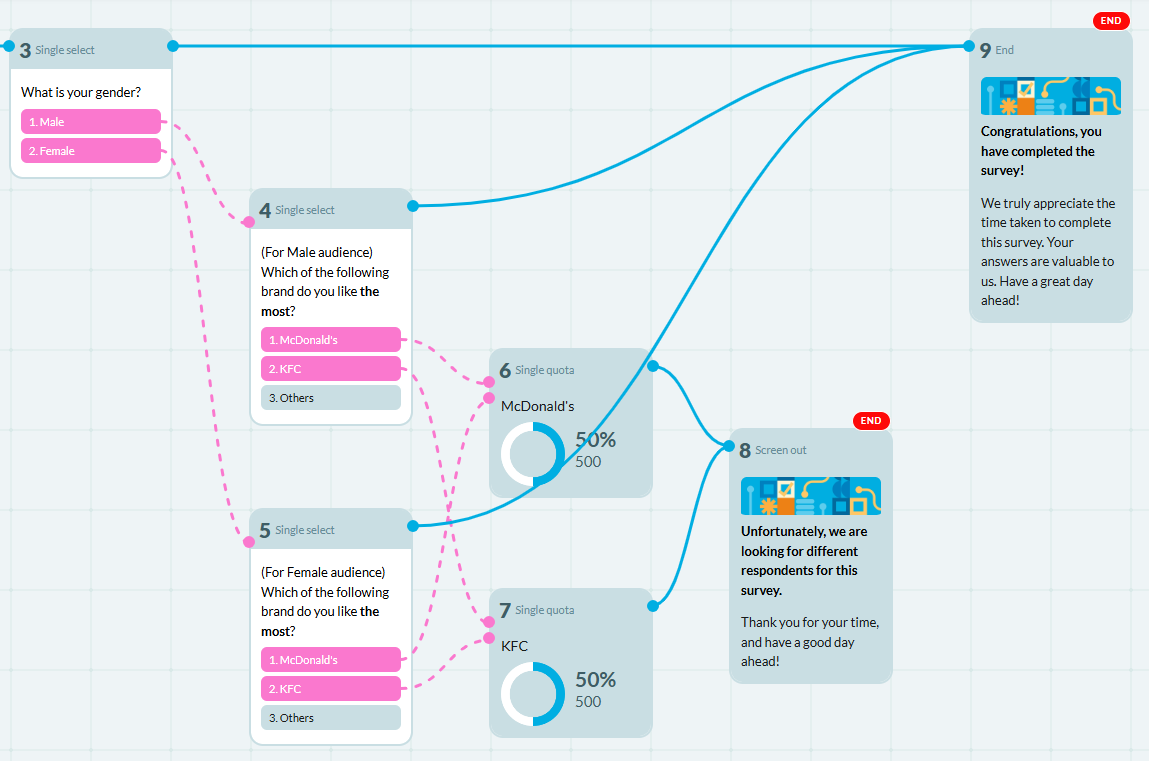In the Visual Editor, you can now enable fuzzy logic for routing between question or logic cards, allowing the subsequent card in the sequence to be executed even if only partial conditions of the route's logic are met.
TABLE OF CONTENTS
- What is Fuzzy Logic?
- Partial AND/OR Logic and Fuzzy Logic Differences
- When to use Fuzzy Logic?
- How to use Fuzzy Logic in Visual Editor
1. Navigating to the Studio (VE - Build)
2. Applying Fuzzy Logic to Question or Logic Cards
What is Fuzzy Logic?
You can use the fuzzy logic feature in Canvas 2.0 to further customise your surveys. When toggled on for a particular card with multiple routing connection from different card, the next (question) card can appear to respondent on condition that at least one of the conditions set is fulfilled (e.g. respondents only answering some questions due to specified routing).
(*Note: by default, fuzzy logic is toggled off, in which respondents have to answer all preceding cards before the follow up card in question)
Partial AND/OR Logic and Fuzzy Logic Differences
In a typical routing logic setup, AND/OR conditions can be applied across answer options within a card or across multiple cards. However, these conditions only work if all relevant cards have been attempted—that is, the logic is triggered only when the respondent has interacted with the cards in question.

For example, in this flow:
- A standard OR condition could be applied between Q4 and Q5, since both follow after the respondent has answered Q3.
- This works under regular logic because the respondent has already interacted with Q3, making Q4 and Q5 valid reference points for routing.
However, Q7 behaves differently. When fuzzy logic is enabled, Q7 will be displayed to respondents who have not answered Q4 option 5 or 6 OR if they went through the route of Q5 and selected "None of them".
By enabling fuzzy logic the survey will take in the possibility of respondents coming from either route.
When to use Fuzzy Logic?
The Routes
- Fuzzy logic off
- If the toggle is left off, the survey will only show the target question after every preceding question that converges onto it has been attempted. This is useful when you need a hard gate—for example, when all prerequisite items must be completed before moving forward (e.g., a mandatory consent check followed by a series of screening questions). This is typically a scenario when there is no diverging routes in the script.
- Fuzzy logic on
- Turning the Fuzzy logic toggle on changes the rule to “at least one” of the preceding questions needing an answer. In this mode the next question appears as soon as the respondent answers any one of the upstream items, allowing the survey to continue even if other linked questions are skipped or unanswered. This is handy for optional branches, exploratory paths, or when you want to keep respondents from hitting a dead‑end because they didn’t answer every possible predecessor.
Guide for Optimised Setting
- When to use the Fuzzy logic (on) setting.
- You want to lower friction and improve completion rates by not forcing respondents to answer every upstream item.
- Certain preceding questions are optional or serve only as additional context, so satisfying just one is enough to justify showing the next block.
- Your survey logic is meant to be permissive (e.g., “show this follow‑up if the participant answered any of the prior screening questions positively.”)
- When to keep Fuzzy logic off.
- All upstream questions are truly required (e.g., legal disclosures, eligibility checks).
- You need to guarantee that respondents have attempted or seen every condition before proceeding, ensuring data integrity for downstream analysis.
Use Fuzzy logic (toggle on) when you want a “soft” gate that lets the next question appear after any preceding question is answered. Keep it off when you need a “hard” gate that requires all preceding questions to be attempted before the respondent can move forward. This lets you tailor the survey flow to either strict compliance or more relaxed.
How to use Fuzzy Logic in Visual Editor
1. Navigating to the Studio (VE - Build)
Access the Studio by clicking on ‘Create a new survey’ from the main page or the Studio page from the main menu. Alternatively, you may also click on an existing study to access its Studio page.

2. Applying Fuzzy Logic to Question or Logic Cards
By default, Fuzzy logic is toggled OFF. To turn it ON, users can navigate to the desired question or logic card, and simply clicking on the Fuzzy logic toggle to the right (highlighted yellow = ON).

Effects of Fuzzy Logic on Quota Card

Fuzzy Logic Setup Setup on Card 6
- The intended route for this survey is between A(Q3>Q4>Q9) or B(Q3>Q5>Q9) with quota checks in between.
- Both quota for McDonald's and KFC are set the same way with exception that Card 6 uses Fuzzy logic while Card 7 does not use Fuzzy logic.
- Selecting McDonald's in either route will trigger the McDonald's quota (Card 6 - Fuzzy logic ON) and increased the quota count by 1, whereas selecting KFC's in either route will not trigger the McDonald's quota (Card 7 - Fuzzy logic OFF).
- Without Fuzzy logic, Card 7 can only be triggered if there exist an attempt to answer both Q4 and Q5 which is not logical for the prepared routes, A and B. Respondents will only be able to answer only one of Q4 or Q5.
See below comparison:
Fuzzy Logic QC Sample by Milieu Customer Success
Effects of Fuzzy Logic on Question Card
Fuzzy Logic Setup on Question Card 8
- The intended route for this survey is between
- AA(Q3>Q4>Q5>Q8>Q10)
- AB(Q3>Q4>Q5>Q9>Q10)
- BA(Q3>Q7>Q6>Q8>Q10)
- BB(Q3>Q7>Q6>Q9>Q10)
- C(Q3>Q10).
- Q8 is set with Fuzzy logic while Q9 is not with Fuzzy logic.
- On Q5 (“How often do you eat out?”), if respondents select Option 2 (“Not often”), Q8 will be triggered as the next question to answer, subsequently letting respondents complete Route AA.
- Despite Q8 traditional routing requires Q6 to be attempted as well, the Fuzzy logic option allows Q8 to be activated and bypass the traditional routing method.
- This is true for Q6 (“Do you regularly exercise?”) if respondents answer Option 2 (“No”). Route BA will be completed in this setup.
- Meanwhile if on Q5 (“How often do you eat out?”), respondents chooses Option 1 (“Often”), Q9 (“Why do you enjoy what you did?”) will not be triggered, and will skip to Q10, resulting in an unintended behavior of Q3>Q4>Q5>Q10 completely ignoring Q9.
- This happens because Q9 does not have Fuzzy logic set up, therefore Q6 (“Do you regularly exercise?”) needs to also be attempted in order for Q9 to activate.
Was this article helpful?
That’s Great!
Thank you for your feedback
Sorry! We couldn't be helpful
Thank you for your feedback
Feedback sent
We appreciate your effort and will try to fix the article
